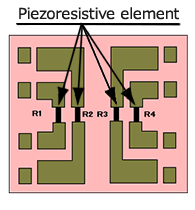Drucksensor Ausgewählte Artikel
Drucksensor Ausgewählte Artikel
- Kapitel 1
- Was ist ein Drucksensor?
1. Umriss
Ein Drucksensor ist ein Gerät, das den Druck einer Flüssigkeit wie eines Gases oder einer Flüssigkeit in ein elektrisches Signal umwandelt.
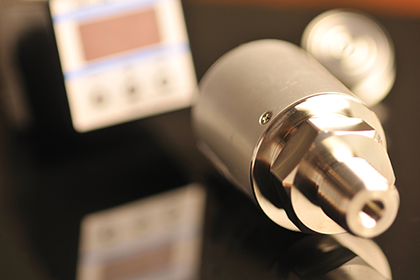
[basierend auf “atmosphärischem Druck”]
[basierend auf “absolutem Vakuum”]
[Messt die Differenz zwischen zwei Drücken.]
- - Inhaltsverzeichnis -
- 1. Was ist ein Drucksensor?
- (1) Umriss
- (2) Funktionsprinzipien
- 2. Einführung unserer Drucksensoren
- (1) Meilensteine
- (2) Reichhaltige Standard-Aufstellung
- 3. Stärken unseres Drucksensors
- (1) Integrierte Inhouse-Produktion
- (2) Sonderprodukte (Benutzerdefiniert-Support)
- 4. FAQ zu Drucksensoren
- 5. Unser Sortiment an Drucksensorserien
2. Funktionsprinzipien
Ein Drucksensor verwendet im Allgemeinen einen Zwerchfell, auf dem Dehnungsmessstreifen gebildet sind, und misst seine Dehnung (oder Durchbiegung) aufgrund der aufgebrachten Kraft über den Zwerchfell-Bereich.
Unser Unternehmen, NIDEC COMPONENTS EUROPE GmbH, bietet zwei Arten von Drucksensoren als Messverfahren an: ein Verfahren mit einem Diffusionshalbleiter (Silikon-MEMS) und ein Verfahren mit einem Dünnschichtmessgerät mit SUS-Membran. Jeder Typ hat seine eigenen Eigenschaften, und wir verfügen über eine Vielzahl von Drucksensorprodukten, indem wir diese beiden Methoden entsprechend der Anwendung und den Marktanforderungen richtig anwenden.
Schauen wir uns das Funktionsprinzip für jeden Typ genauer an.
Ⅰ. Silikon-MEMS (Si-MEMS)
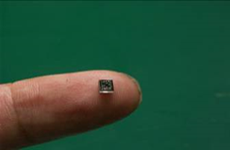
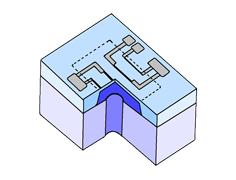
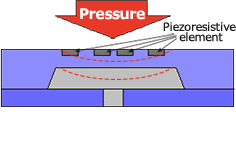
Querschnittszeichnung
Die vier Dehnungswiderstände, die wie in der Abbildung unten gezeigt angeschlossen sind, bilden eine Wheatstone-Brückenschaltung. Diese Brückenschaltung wird mit konstantem Strom (nominell 1,5 mA DC) betrieben. Bei Druckbeaufschlagung erhöhen sich die Widerstandswerte von R2/R3, während die von R1/R4 abnehmen, was zu einer Ungleichheit in der Brückenschaltung und einer Spannungsdifferenz am Ausgangsende führt. Diese Spannungsdifferenz wird zu einer dem Druck proportionalen Ausgangsspannung. Auch beim Anlegen von Unterdruck werden die Polaritäten ebenfalls in die gleiche Orientierung wie bei Anlegen eines Überdrucks umgekehrt.
Zur Erläuterung der Druck- und Leistungskennlinie ist die Verformung des Zwerchfells in der rechtenim weiter oben stehenden Zwerchfell-Querschnittszeichnung vergrößert dargestellt, wobei der Verformungsgrad jedoch nur wenige Mikrometer beträgt. Daher ist die mechanische Verformung des Zwerchfells optisch kaum zu erkennen.
Ⅱ. Dünne-Schichten-Sensor (mit SUS-Zwerchfell)

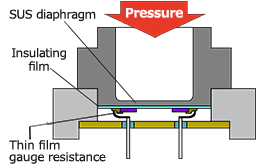
Querschnittszeichnung
Ⅱ. Dünne-Schichten-Sensor (mit SUS-Zwerchfell)
In einem Dünne-Schichten-Sensor, wie bei Si-MEMS, sind vier Dünne-Schichten-Widerstände verbunden, wie im folgenden Schema gezeigt, um eine Wheatstone-Brückenschaltung zu bilden. Die Dünne Schichten Messwiderstände werden mit konstanter Spannung angesteuert. Der SUS-Zwerchfell verformt sich bei Druckeinwirkung, die auf dem Zwerchfell gebildeten Dünne Schichten Widerstände verformen sich, die dann jede Änderung des Widerstandswertes des Messgerätes erkennen. Somit kann ein Spannungssignal proportional zum Druck erhalten werden.
- Kapitel 2
- Einführung unserer Drucksensoren
1. Meilensteine
Wir liefern seit etwa 40 Jahren Drucksensoren, beginnend mit der Herstellung und dem Vertrieb von Drucksensoren für elektronische Blutdruckmessgeräte im Jahr 1980. Dank Ihnen werden unsere Drucksensoren in verschiedenen Branchen wie Halbleiterfertigungsanlagen, Industrieanlagen, Medizinische Ausrüstung, Analysator, Messinstrument und hydraulische Geräte wie Bearbeitungszentren.
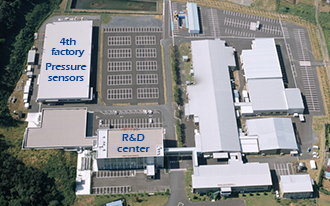 Sano Plant satellite-photo
Sano Plant satellite-photo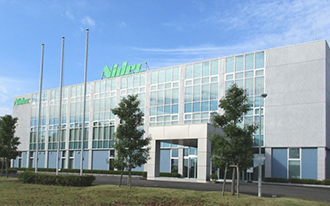 Sano R&D center
Sano R&D center
Die Basis dieses Geschäfts wird das Sano-Werk in der Präfektur Tochigi, Japan. Wir handhaben alles von Sensorchips bis hin zu fertigen Drucksensorprodukten und haben sich heute zu einem führenden Geschäft unseres Unternehmens entwickelt.
2. Reichhaltige Standard-Aufstellung
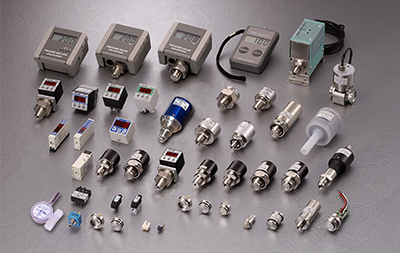
| Sensor methode | Si-MEMS (Si Einkristalle) | Si-MEMS (Dual Zwerchfell) | SUS-Zwerchfell mit Dünne-Schichten-Sensor |
|---|---|---|---|
| Struktur | 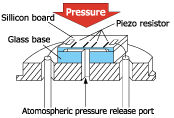 |
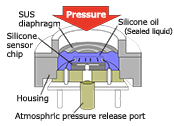 |
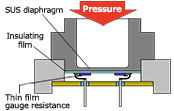 |
| Si-Einkristallelement wird durch anodisches Bonden über im Glas enthaltene Na-Ionen mit dem Glasboden verbunden. Das Si-Einkristallelement nimmt das Medium direkt auf. | Eine SUS-Zwerchfell wird mittels Laserschweißen mit dem Gehäuse verbunden und überträgt über das Silikonöl Druck auf den Silikon-Sensorchip. | Ein Dünnfilmmeßgerät wird mittels Dampfabscheidung auf einer SUS-Zwerchfelln über einen Isolierfilm gebildet. | |
| Medien | Nicht korrosive Gase | Gase oder Flüssigkeiten, die das SUS-Material im medienberührten Teil nicht angreifen | Gase oder Flüssigkeiten, die das SUS-Material im medienberührten Teil nicht angreifen |
| Features |
|
|
|
|
Unsere Drucksensor-Serien Line-up | |||
|
Pressure |
P-2000, P-3000S | P-8300, P-8305, P-8505 | ― |
|
Pressure |
PA-20, PA-100, PA-500 | P-7100, PA-750/758, PA-800, PA-830/838, PA-838-D, PA-850/858, PA-860/868 |
High vacuum: PA-920S/928S
High temperature: PA-930/930-A |
| Pressure switch | PS20, PS30, PS40, PS6, PS60 | PS8, PS83, PS85, PS86 | High vacuum: PS91, PAS91 |
|
PG-30, PG-200,PG-100N | PG-35, PG-75, PG-208, PG-100B | High vacuum: PG-20, PG-35L High pressure: PG-35H |
In recent years, we've been aggressively releasing new products such as types with a built-in small amplifier with ratiometric output and types for high vacuum and high temperature using SUS diaphragm with thin film elements, and we are expanding our business domain.
- Kapitel 3
- Stärken unseres Drucksensors
1. Integrierte Inhouse-Produktion
We manufacture in-house from sensor elements by making full use of semiconductor technology, and further develop and manufacture pressure sensor final products through processes such as mounting, temperature compensation, electronic circuit addition and casing, etc.
-
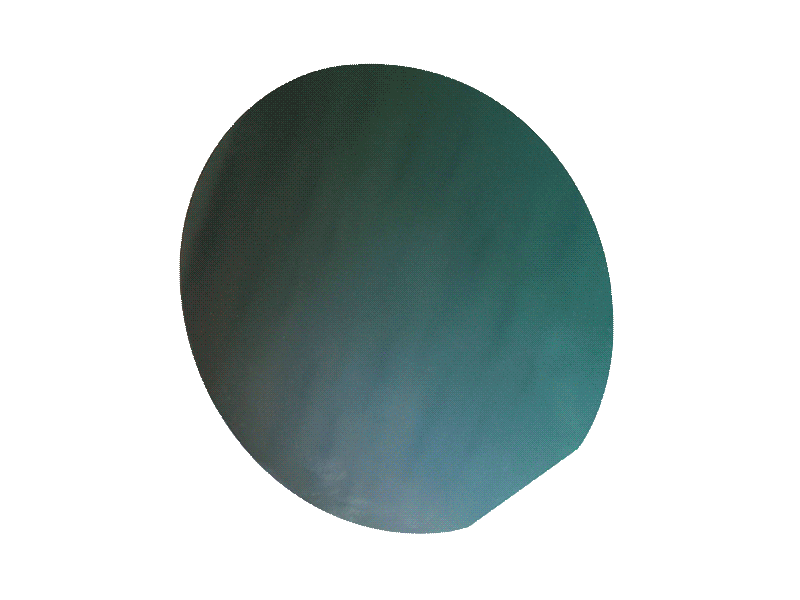
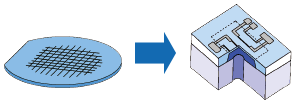
Silikonwafer ⇒ Sensor chip 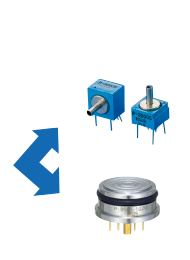
Pressure sensor module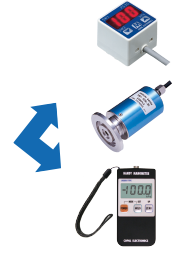
Pressure sensor products
with amp.
A major feature of our pressure sensor is that we handle everything from development design to sensor element manufacturing process and product assembly process / calibration under the integrated quality control of our pressure sensor business based on high-mix low-volume production. Our strength lies in this business structure, which is capable of responding to special specifications and various customer needs in detail.
2. Sonderprodukte (Benutzerdefiniert-Support)
― Policy for custom support ―
Our policy for customizations is as follows:
- If we can apply our existing products / technologies and judge that they can be commercialized in consideration of business feasibility, we will actively accept custom support.
- Even if the technology we have is scarce at the time of your request, we will consider it positively if we judge that joint development is possible.
- We will proactively propose the products and services that our customers need by collecting information by industry unique to us.
Our pressure sensors have a total of 92 models, and the P/N of models is 1,992. Of these, Customizations, so-called Special products, accounts for nearly 80% of the total on a monetary basis, and as the results show, we have provided many custom products and services that meet the individual needs of the market and customers. Introduce some examples of the special products bellow.
Customization examples
Electrolytic polishing + Degreasing + Clean packaging
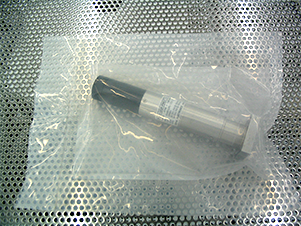
PA-750/758 series: Compatible with cable connectors and Direct cable from body
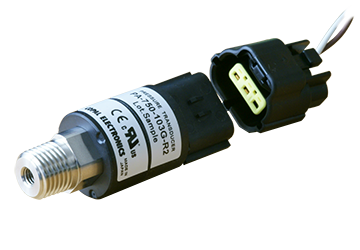 Standard model
Standard model

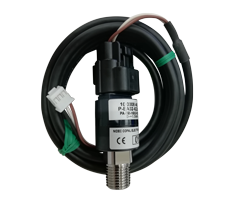 (1) Cable with connectors
(1) Cable with connectors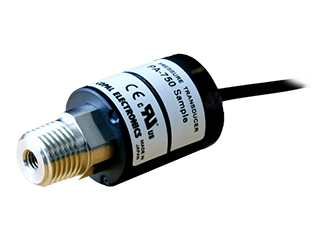 (2) Direct cable from body
(2) Direct cable from body
The PA-750/758 standard series uses a connector cable that the body and cable can be attached and detached, and the cable tip has a lead wire. We have both achievements in supporting (1) the installation of designated tip connectors and (2) direct cable removal from the main unit.
PS20 series: Special fitting
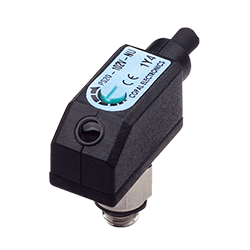
Standard model

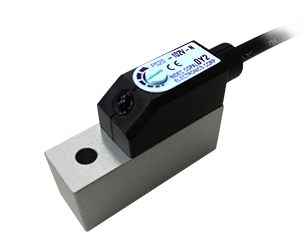
Special fitting
The PS20 standard series is M5 male screw or block M5 female screw, but we have made a proposal to meet the market needs to extend the tip of the block, make an hole for M5 female screw, and fix it with a mounting screw.
Other examples
Specification / Performance change
| Pressure range / Pressure unit | Pressure range: Provision of range other than that in standard products, change of standard pressure unit (e.g. PSI, etc.) |
|---|---|
| Performance | Accuracy enhancement (e.g. output calibration error, improvement of temperature characteristic, improvement of pressure resistance, etc.) |
| Output | Analog output value, support for I2C/SPI, and others |
| Power voltage | Change to desired power voltage |
| Ambient temperature | Change to specification suitable for desired ambient temperature |
| Switch setting | Shipment with a desired pressure threshold setting |
| Zero adjustment | Addition of zero adjustment setting |
Appearance / shape change
| Fitting | Shape, size, material, etc. |
|---|---|
| Cable | Length, lead wire diameter, connector processing, terminal processing, tag attachment, etc. |
| OEM design | Name plate, panel design, casing color, etc. |
Others
| Custom development | Manufacturing of circuit board, unit design, custom-made shape, etc. |
|---|
With our experience and expertise, we will propose the best products and services that meet your needs. Please feel free to contact us from the button below.
- Chapter 4
- Pressure sensors FAQ
1. About Products
| 1. About cable specifications | |
|---|---|
| Q. We want to attach a connector to a cable. Where can we find your cable specifications? | Answer |
| 2. Scope of non-corrosive gases in medium | |
| Q. For use with P-2000 or P-3000S, you require a non-corrosive gas as the pressure medium. Can steam-laden air be used? If not, which model would you recommend? | Answer |
| 3. How to clear noises (Wiring shield cable) | |
| Q. The transducer that we use has a built-in amplifier. Its output fluctuates, and it appears that noise is the cause. The mounting side is insulated. The shielding wires on the receiver side are disconnected during use. What measures should be implemented? | Answer |
| 4. How to set switch of pressure switch | |
| Q. We plan to use a KF25 flange fitting with a PS91 vacuum switch to monitor atmospheric pressure and detect when a vacuum heating oven is under atmospheric pressure. We are unsure how to select N1 and N2 and would appreciate your advice. We imagine that the vacuum switch turns on when the pressure returns from a vacuum to atmospheric pressure. How should the switch output be set so that the vacuum switch turns on at -80 kPa as the pressure changes from atmospheric to a vacuum? | Answer |
| 5. Mounting on PCB (Manual soldering required) | |
| Q. We want to solder a P-2000 onto a printed circuit board. What are your recommended soldering conditions? | Answer |
| 6. Recommended fittings for M5 female screws connecting tubes | |
| Q. We want to connect a pressure sensor to its tube using an M5 female screw. What attachment do you recommend? | Answer |
| 7. Recommended tubes for quick fittings | |
| Q. What tubes do you recommend for use with the quick fittings? | Answer |
| 8. How to installate to piping (Tightening torque) | |
| Q. What tightening torques do you recommend for tapered screw types? | Answer |
| 9. ffect of vertical to horizontal installation position | |
| Q. The dual-diaphragm pressure sensor we use varies in output depending on whether the pressure port is turned downward or sideways. Does this mean the sensor is out of order? | Answer |
| 10. Stability after power applied | |
| Q. According to the Common Notes, a warm-up time of about 10 minutes after power-on allows more accurate measurement. How much does the output voltage [V] fluctuate during the 10 minutes after power-on? We also want to know whether the output voltage changes linearly or not. | Answer |
| 11. Products selection suitable for using high vacuum | |
| Q. We introduced the PA-850-102A-NR2 to monitor the pressure inside the vacuum chamber. Our process requires reducing the pressure to an absolute pressure of approximately 0 kPa. However, the brochure specifies an operating vacuum lower limit of 1.3 kPa abs. Why is it unusable beyond this value? Please recommend pressure sensors that can be used beyond this value. | Answer |
| 12. About operating temperature range of medium | |
| Q. What is the liquid temperature range applicable to the PG-35? Although we are currently using room-temperature water, we want to use heated water and hence have to know the liquid temperature range. | Answer |
| 13. Effect of accuracies by ambient temperature | |
| Q. How come the PG-100B has two different system accuracies, one being ±0.5%F.S. ±2 digits and the other being ±1.0%F.S. ±2 digits? Besides, what does "±2 digits" mean? | Answer |
| 14. Rated pressure range / Max. pressure / Break pressure | |
| Q. What does the rated pressure range and maximum pressure in the specification mean? Will the sensor be broken if the burst pressure value is exceeded? | Answer |
| 15. How to purchase lithium batteries for PG-100 | |
| Q. The replacement battery specified for the PG-100 manometer is a 3.6 VDC lithium battery. The battery originally supplied with the PG-100 is manufactured by Toshiba and bears the model number ER6VM/3.6. This model cannot be found on Toshiba's website, though the ER6V P3.6 model can. Would it be okay to use the latter instead? | Answer |
| 16. Product lineup in accordance with UL991 | |
| Q. We are considering using a pressure sensor for a semiconductor manufacturing machine. Are UL991-compliant ones available from you? | Answer |
| 17. How to solve E2 ERRORs in pressure gauges | |
| Q. We restarted a PG-75 for the first time after long-term non-use. Its zero adjustment resulted in an "E2 Error" message. How should this be dealt with? | Answer |
| 18. Effects of the use of not specified power supplies | |
| Q. According to its specifications, the P-3000S operates with a standard constant current of 1.5 mA. Would there be any problems if it were driven with a constant voltage of 5 V? Additionally, how will the accuracy of linearity and the temperature characteristics be affected if a 1 mA current is set for constant current drive? | Answer |
| 19. How to solve Zero Point ERRORs in pressure gauges | |
| Q. The PG-100 handy manometer we use reads "-00.3" at power-on. The normal reading should be either "00.0" or "00.1." Is our PG-100 out of order? | Answer |
| 20. Batteries replacement notice of Manometers | |
| Q. Is it normal that the reading by the PG-100 manometer appears thin when its battery is running low? Does a dying battery result in a reading lower than the actual pressure? Is there any method we can check with as the reference for the time to replace the battery? | Answer |
| 21. About elements and materials of pressure sensors | |
| Q. We have adopted the PG-35 pressure gauge as the atmospheric pressure detector for our vacuum equipment. The specifications for an end user who has inquired about our vacuum equipment require that the atmospheric pressure sensor be a semiconductor sensor with a stainless steel diaphragm. Does the PG-35 meet this requirement? | Answer |
| 22. Manometers selection for organic solvent medium | |
| Q. We want to use a PG-100-102A at hand to measure a fluid containing a diluted organic solvent. Is this possible? | Answer |
| 23. Use at high altitudes / Kind of pressure references | |
| Q. We are considering using a PS6-102G-NAR at an altitude of 1,000 meters. Would this be possible? | Answer |
| 24. Out of Production | |
| Q. What is the discontinuation information for the pressure sensor? | Answer |
| 25. How to operate the settings of Pressure gauge PG-30/PG-35? | |
| Q. Could you please explain how to set up and operate the PG-35L pressure gauge? Is there explanatory material that beginners can understand? | Answer |
2. Documents and Certificates
| 26. How to obtain certificates of non-applicability | |
|---|---|
| Q. We need a certificate of non-applicability to export a single product to a customer overseas. How can we obtain a certificate of non-applicability? | Answer |
| 27. How to get CAD data | |
| Q. Can we get 2D/3D CAD data of your products? | Answer |
| 28. How to obtain declaration of CE conformity | |
| Q. How can we get the declaration of CE conformity of your pressure sensor? | Answer |
| 29. How to obtain ISO9001 / 14001 certificates | |
| Q. We understand you are an ISO 9001/14001 certified company. Can we obtain a copy of your certificate? | Answer |
| 30. About failure rates of products | |
| Q. We would like to know the failure rates of your products. Could you provide us with the failure rate data? | Answer |
| 31. How to obtain RoHS3 compliant certificates | |
| Q. Are your products compliant with RoHS Directive (EU) 2015/863? | Answer |
| 32. How to obtain UL certificates | |
| Q. Our product requires a safety review for which we need a UL certificate for your product. May we obtain a copy of this certificate? | Answer |
3. Maintenance and Calibration
| 33. Models for calibratable services / How to obtain the certificates | |
|---|---|
| Q. We use a PG-100B. Do you offer calibration services for this model? | Answer |
| 34. Investigation of faults / Repair / Replacement | |
| Q. After powering on, the PG-100 displays "-1." This reading does not change even under pressure. Do you know what causes this? Can this issue be resolved? | Answer |






